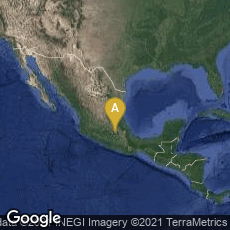

A: Bosque de Chapultepec I Sección, Ciudad de México, Ciudad de México, Mexico
The Aztec calendar stone or Aztec Sunstone Calendar, carved in basalt, is 3.6 meters (12 feet) in diameter and weighs about 24 metric tons. Containing images representing Aztec measurement of days, months, and cosmic cycles, the stone was completed during the 52 year period between 1427 and 1479 CE. It was originally placed atop the main temple in Tenochtitlan, the capital of the Aztec empire, facing south in a vertical position and was painted a vibrant red, blue, yellow and white.
When the Spaniards conquered Tenochtitlan in 1521 they buried the stone, and built the cathedral of Mexico City on the site. For over 250 years the stone was lost until December of 1790 when it was excavated by accident during repair work on the cathedral. Today it is located in the Museo Nacional de Antropologia, Mexico City.
"The stone was first described by the Mexican astronomer, anthropologist and writer, Antonio de León y Gama in Descripción histórica y cronológica de las dos piedras: que con ocasión del empedrado que se está formando en la plaza Principal de México, se hallaron en ella el año de 1790. Impr. de F. de Zúñiga y Ontiveros, 1792. "In it Leon y Gama described the discovery in 1790 of two of the most important pieces of aztec art in the Zócalo, main plaza of the city of Mexico: the sun stone and a statue of Coatlicue, an aztec goddess. Leon y Gama also included in it most of his knowledge and theories on how Aztecs measured time. The work, as opposed to authors of previous centuries, praised Aztec society and their scientific and artistic achievements in line with the growing Mexican nationalism in the late 18th century. It was published by Felipe de Zúñiga y Ontiveros, [scientist and cartographer and] owner of one of the most important printing establishments in America at the time. In addition to print the book had three folded manuscript watercolor drawings [presumably hand-colored engravings.] Thanks to the publication of the book Leon y Gama is considered by many the first Mexican archeologist" (Wikipedia article on Antonio de León y Gama, accessed 01-01-2010).